Tour de France Femmes avec Zwift 2024
By Mikkel-T ([email protected])
Posted on Aug 5, 2024
Contents
Intro
For the first time ever, the Tour de France Femmes avec Zwift will start outside France with 3 flat stages in and around Rotterdam. With the race starting soon, we wanted to make a small preview of all the stages. As there already exist lots of previews analyzing stages and which riders and rider types can win them, we wanted to try something different. This preview will take a look at the stages, their profile and key points (of course with our own sanluca.cc graphics), and then we will have a focus on the different classifications and jerseys. First we will explain each of the jerseys and how to get points for them and then for each stage we will add a Jersey Ranking stating how important a stage is for the fight for a jersey (and that final classification).
This year, the riders of the Tour de France Femmes will cover a distance of 949.4 kilometers in the pursuit of the Maillot Jaune, they will do so over 8 stages with a total vertical gain of 11750 meters. The race starts off with 3 flat stages on 2 days in Rotterdam, and finishes up the mythical Alpe d'Huez on stage 8.
To make this preview, only the tools available for all visitors on sanluca.cc have been used. If you want to explore the race yourself, click here.
The jerseys
The jerseys of the Tour de France and Tour de France Femmes need no introduction. They are well-known symbols in both cycling and sports in general, still we will just quickly go over each of them together with information about the different competitions.
- For the general classification, the riders will be battling for the Maillot Jaune (Yellow Jersey), one of the most iconic pieces of clothing not only in cycling but sports in general.
- The sprinters will be fighting for the Maillot Vert (Green Jersey), a jersey that can be obtained by getting points in both intermediate sprints and on the finish line. The points will be given to the first 15 classified riders on the following parts of the race:
- Intermediate sprints (on stages 1, 4, 5, 6, 7, 8): 25, 20, 17, 15, 13, 11, 10, 9, 8, 7, 6, 5, 4, 3, 2
- Stages 1, 2 and 5: 50, 30, 20, 18, 16, 14, 12, 10, 8, 7, 6, 5, 4, 3, 2
- Stage 3 (ITT): 20, 17, 15, 13, 11, 10, 9, 8, 7, 6, 5, 4, 3, 2, 1
- Stages 4 and 6: 30, 25, 22, 19, 17, 15, 13, 11, 9, 7, 6, 5, 4, 3, 2
- Stages 7 and 8: 20, 17, 15, 13, 11, 10, 9, 8, 7, 6, 5, 4, 3, 2, 1
- The maximum number of points a rider can score in this classification is 390.
- The climbers will try to see if they can take the Maillot à Pois (Polka dot Jersey), which is obtained by collecting points on categorized climbs.
- Cat 4: 2, 1
- Cat 3: 3, 2, 1
- Cat 2: 5, 3, 2, 1
- Cat 1: 10, 8, 6, 4, 2, 1
- HC: 15, 12, 10, 8, 6, 4, 2, 1
- The maximum number of points a rider can score in this classification is 114.
- For the young riders, the battle will be about the Maillot Blanc (White Jersey), which works like the Maillot Jaune but is only given out to riders born in 2002 and after.
The stages
Stage 1
Explore this stage in detail with our interactive map.
The first stage of this year's Tour de France Femmes will go from Rotterdam to Le Haye (The Hague). It is a flat stage with the only elevation being the two times the peloton passes under the Scheur in the Maasdeltatunnel (a cat. 4 climb the second time). The stage has a distance of 122.8 kilometers and also has an intermediate sprint at kilometer 84.9.
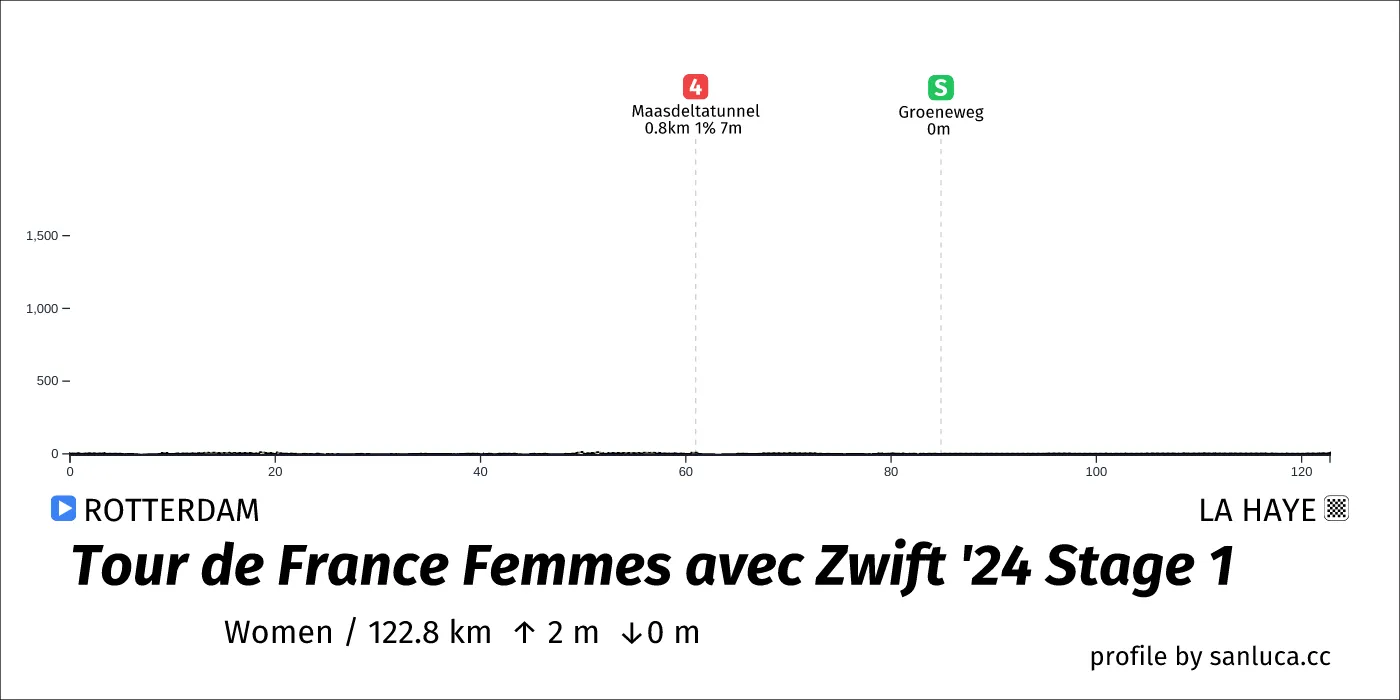
With a stage profile like this, we are guaranteed a sprint between the fastest women in the peloton. The run-in to the sprint is fairly simple with the final corner being at 3.1 kilometers to go. Before that, they will have done a trip around the Zuiderpark, but there should be time to position your sprinter.
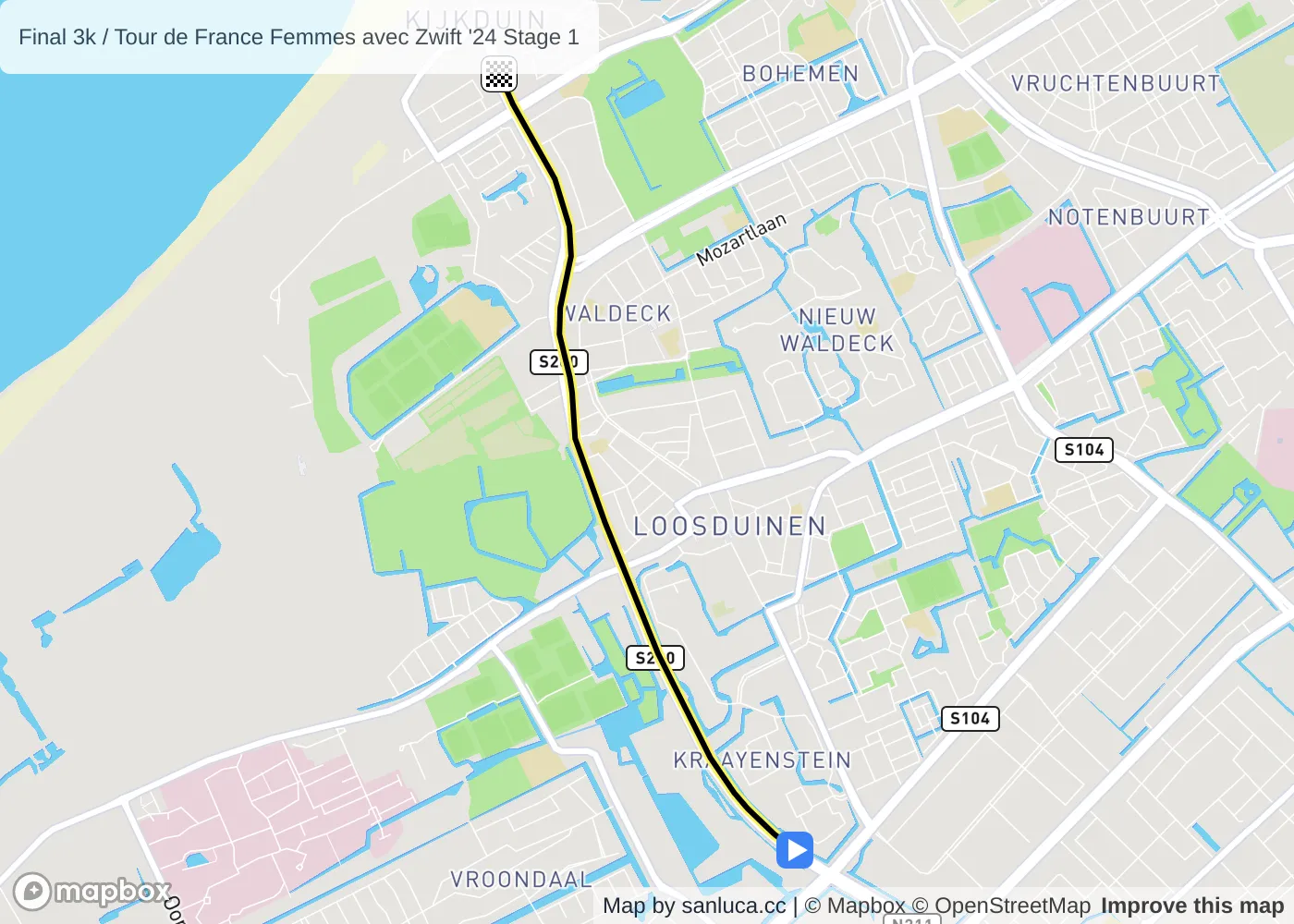
The jerseys
Maillot Jaune and Blanc
For the GC riders, the biggest objective of this stage is to not lose any time on their opponents which means the importance of this stage is close to none for the final GC battle. Although this stage is not important for the fight for both the final fight, the winner of this stage and the first young rider over the line will be the wearers of these jerseys on stage 2.
Importance: 0.5/10 (but 10/10 for a chance to wear the jerseys)
Maillot Vert
This stage could prove itself extremely important in the fight for the Maillot Vert as there is both an intermediate sprint and a sure sprint finish with a maximum of 70 points up for grabs if you get everything. That is almost a fifth of the points available, and a much bigger share when the stages not suited for sprinters are removed from the equation.
Importance: 9/10
Maillot à Pois
With this being the first stage, there will of course be a fight for the Maillot à Pois which can then be worn on stages 2, 3 and 4, especially among the teams without a sprinter who have nothing else to fight for today. Though in the final classification, the 2 points available today are not going to mean anything in the end.
Importance: 0/10 (but 10/10 for a chance to wear the jersey)
Stage 2
Explore this stage in detail with our interactive map.
One of two stages being ridden on august 13th, this stage is a short sprint stage of 69.3 kilometers going from Dordrecht to Rotterdam. This stage is even flatter than stage 1 while also having no intermediate sprints or categorized climbs.

With no intermediate sprints or categorized climbs, the only thing to fight for on this stage is the sprint. The run-in to the sprint is more technical than on stage 1, and good positioning in the final is key.
With around 3k to go, the peloton will ride over the Willemsbrug on which they will have a 90 degree curve with 2.7k to go. Then 4 90 degree corners with 2.5, 2.15, 1.5 and 1.2 kilometers to go after which it is almost straight to the line.
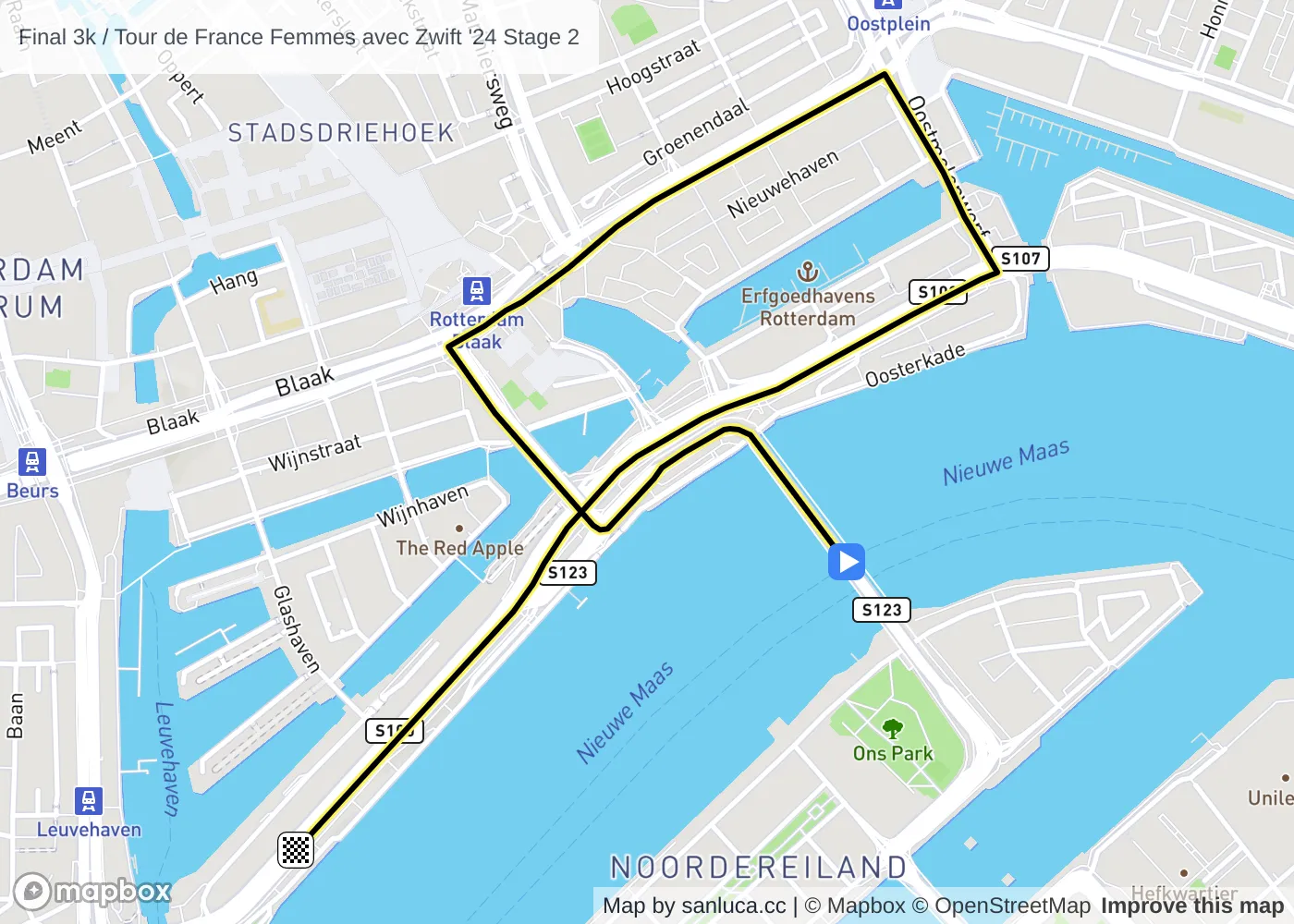
The jerseys
Maillot Jaune and Blanc
Just like on stage 1, the most important mission for the GC riders on this stage is to ensure they don't lose seconds to competitors.
Importance: 0.5/10
Maillot Vert
Another sprint stage means another important battle for the Maillot Vert. With 50 points on the line again, a rider can definitely get a comfortable lead in the points classification if they are placed good in this stage as well.
Importance: 8/10
Maillot à Pois
No categorized climbs.
Importance: 0/10
Stage 3
Explore this stage in detail with our interactive map.
The second stage of the day, a short and flat ITT of only 6.3 kilometers. With such a short TT, the possibility of doing huge damage or winning by huge margins is limited. The route is primarily flat with the only points of elevation being the two bridges that are being crossed along the route.
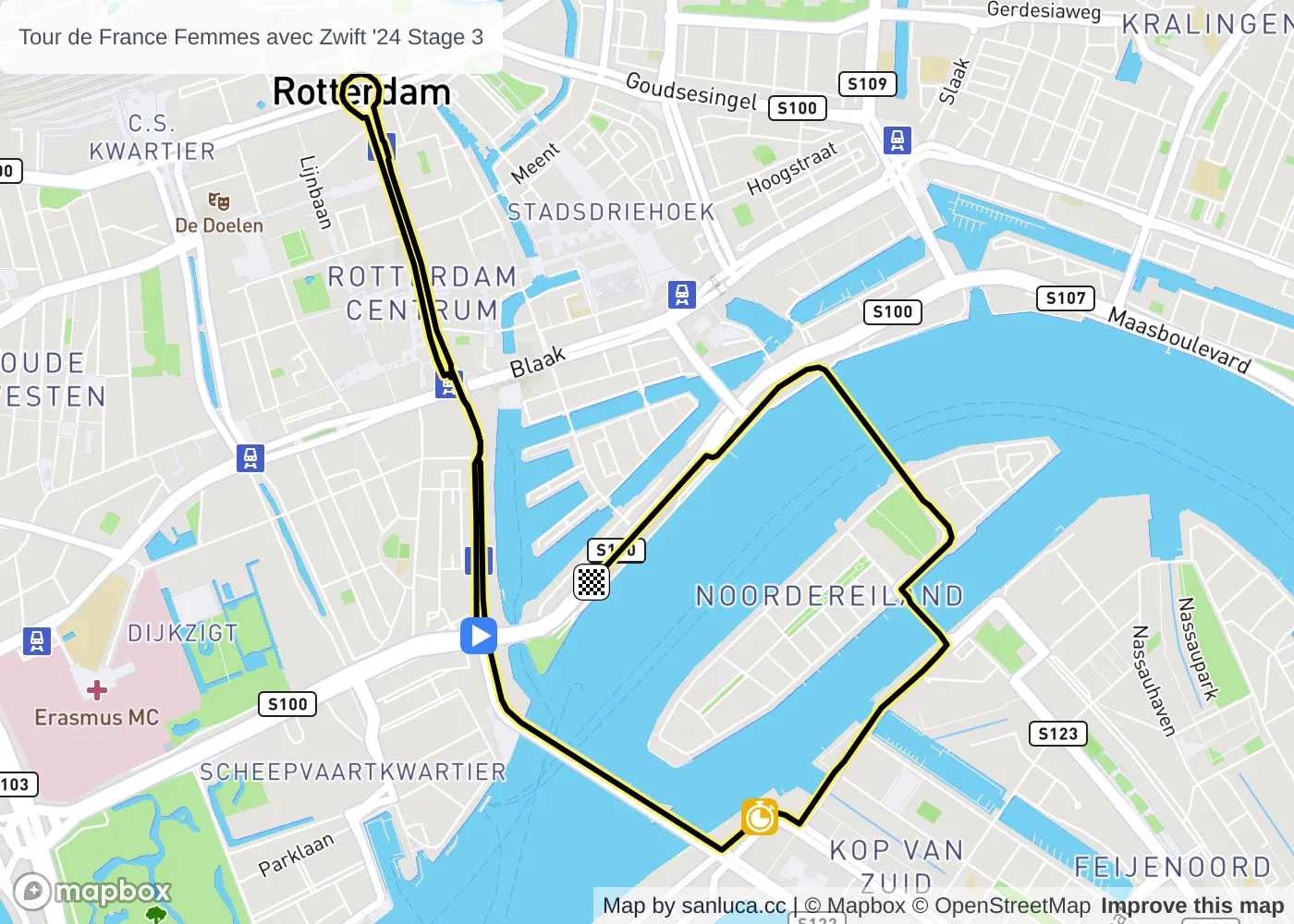
This stage should be a battle between the top TT riders and powerhouses of the WWT peloton and will probably be won by a small margin. What is almost the wildest part is that ASO has decided put in a checkpoint at km 3.9 even though riders are going to be at the finish line two minutes after that.
The jerseys
Maillot Jaune and Blanc
With both the length and hardness of the route in mind, this should not create gaps of more than maybe 10-15 seconds between the top GC contenders and is therefore not super important compared to some of the later stages.
Importance: 2/10
Maillot Vert
With only 20 points on the line for the first place, and a relatively small chance of many sprinters being in contention for the super good points, this stage doesn't really appeal much to the ones chasing the Maillot Vert.
Importance: 2/10
Maillot à Pois
No categorized climbs.
Importance: 0/10
Stage 4
Explore this stage in detail with our interactive map.
Stage 4 of the Tour de France Femmes, the peloton are going to the second country of this race but they have yet to reach France. This stage is a mix of the finals from two well-known races: Amstel Gold Race and Liège-Bastogne-Liège. Starting off in Valkenburg doing the AGR lap twice, then riding around 56 kilometers before joining the roads of LBL just before la Redoute, for a total of 122.8 kilometers.
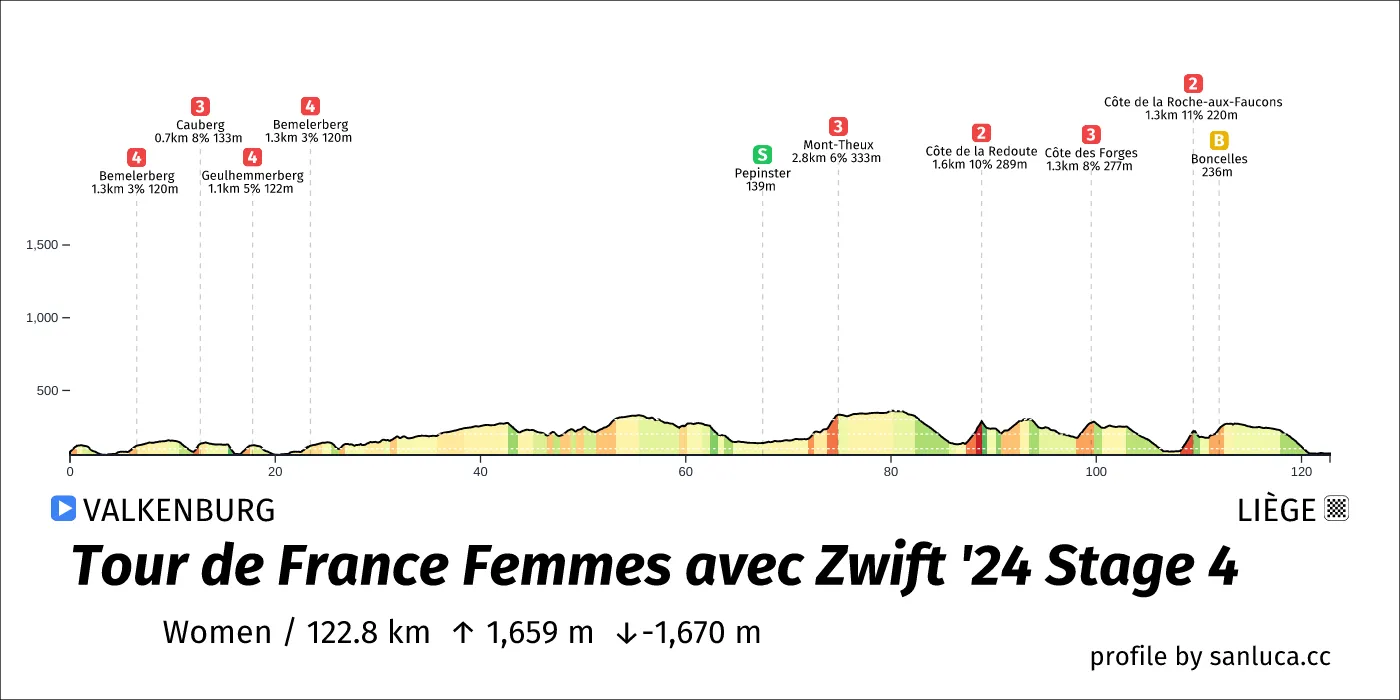
This stage includes 3 cat. 4 climbs, 3 cat. 3 climbs and 2 cat. 2 climbs together with an intermediate sprint and a bonus sprint. It has almost 1700 meters of vertical gain and is the perfect terrain for attacks. One likely scenario could be that a break forms while on the AGR lap, and that the GC riders will try to test each others in the final by attacking up climbs like la Redoute or Roche-aux-Faucons. Due to how easy the first 3 stages have been, the chance of a break going all the way should be relatively small.
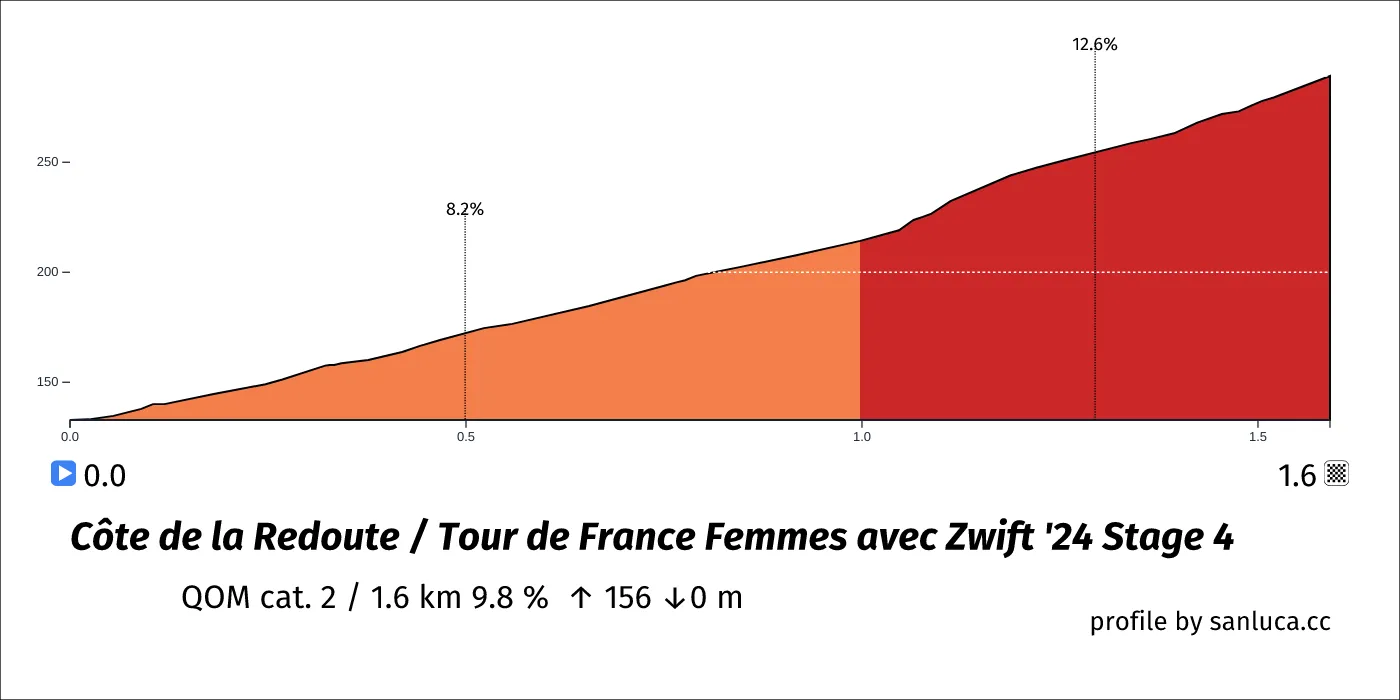
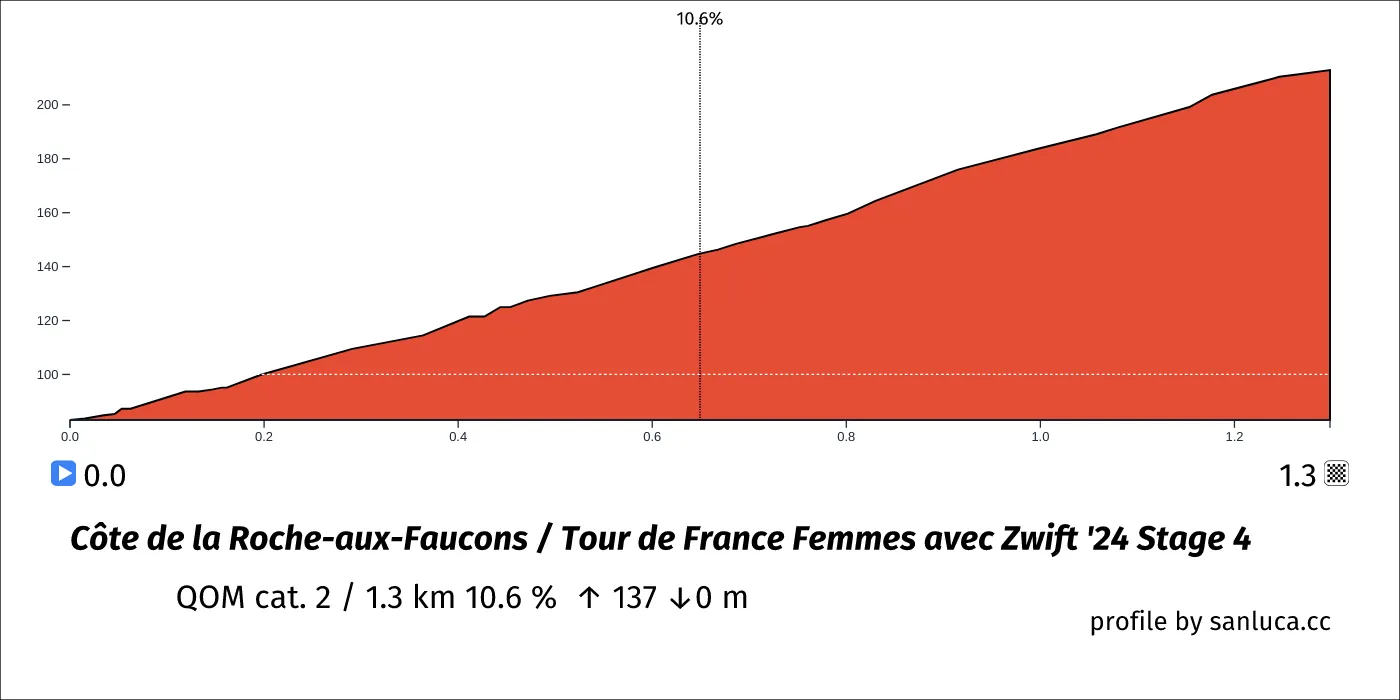
With two fairly easy stages after this, there shouldn't be anything stopping the GC contenders from testing their competitors, perhaps other than the distance to the finish line (unfortunately). There are also 6, 4 and 2 seconds up for grabs in the bonus sprint with 10.8 kilometers to go.
The jerseys
Maillot Jaune and Blanc
Depending on whether or not the GC riders want to test each other, this stage could definitely be fun and interesting for the GC. Still this isn't as hard as the real mountain stages later on in the race, but will hopefully give us an idea about the GC contenders and could create gaps like we have seen in LBL.
Importance: 6.5/10
Maillot Vert
With this final, it will be very hard for a pure sprinter to get all the way to the finish, and the battle for the Maillot Vert will therefore probably stop at the intermediate sprint with 55.3 kilometers to go with 20 points as the max.
Importance: 3/10
Maillot à Pois
With around a fifth of the points for the Maillot à Pois being up for grabs today (25), a rider can get a comfortable lead, especially in the LBL part of the stage. This still isn't a lot though and the chance that one rider wins all the points is quite slim, but can again be a start for the riders not looking for GC but still a jersey.
Importance: 6/10
Stage 5
Explore this stage in detail with our interactive map.
It is now stage 5 of the Tour de France Femmes, and the race finally passes into France for a total of 3.5/8 stages of the race being raced in France (but around 60% of the total distance). This stage is a 152.4 km hilly stage taking the peloton from Bastogne to Amnéville. The 50 points for the Maillot Vert given at the finish suggests that this is a completely normal sprint stage, and it very well could be, but it could also potentially be a day where a late attack just might go all the way home.
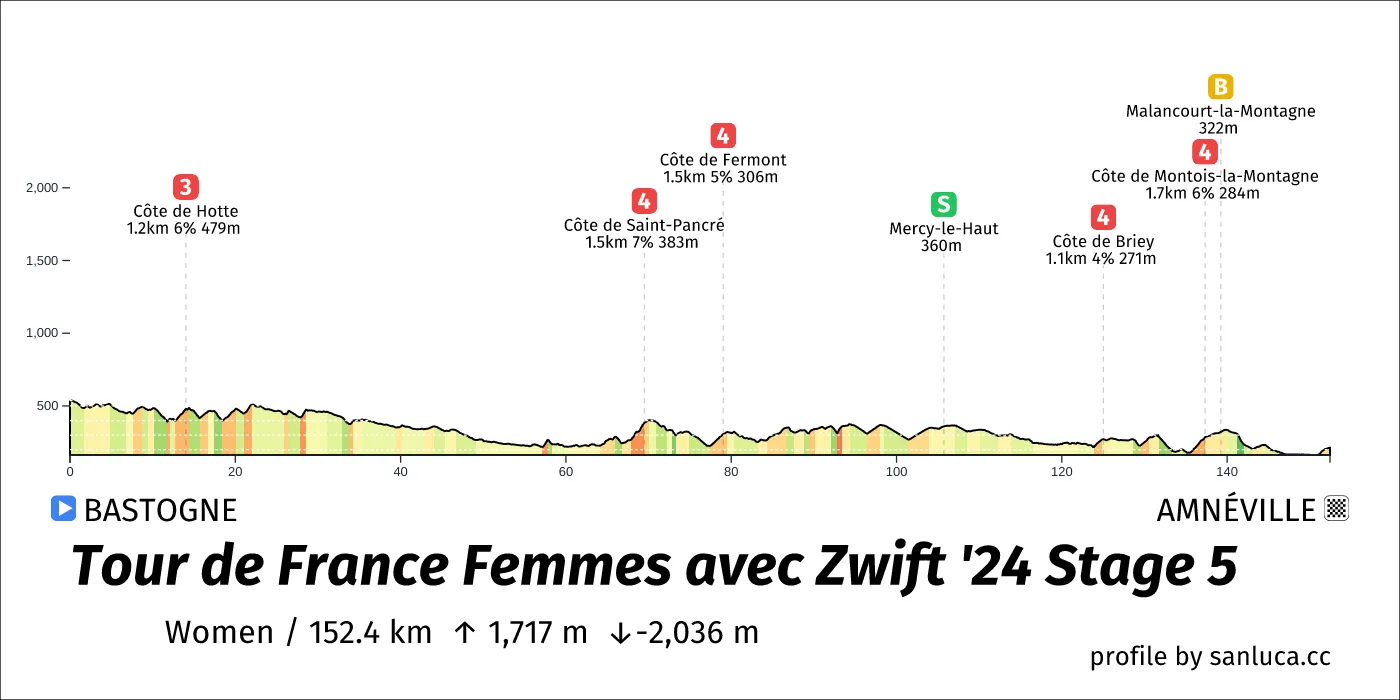
The stage is designed in a way that an early break should be able to get away on the first hilly part, then mostly a calm and relaxing stage with some cat. 4's all the way to the last categorized climb.
Côte de Montois-la-Montagne starts at 16.9 km to go and ends at 15.1 km to go, making it 1.7 km long with an average gradient of 6%, it doesn't stop there though. After the QOM, there is still a slightly uphill part (2.5 km 2%) up to the bonus sprint Malancourt-la-Montagne at 13.2 km to go. If a group of (maybe GC) riders decide to attack on this hill and go for the bonus sprint, we might see a chase all the way to the line.
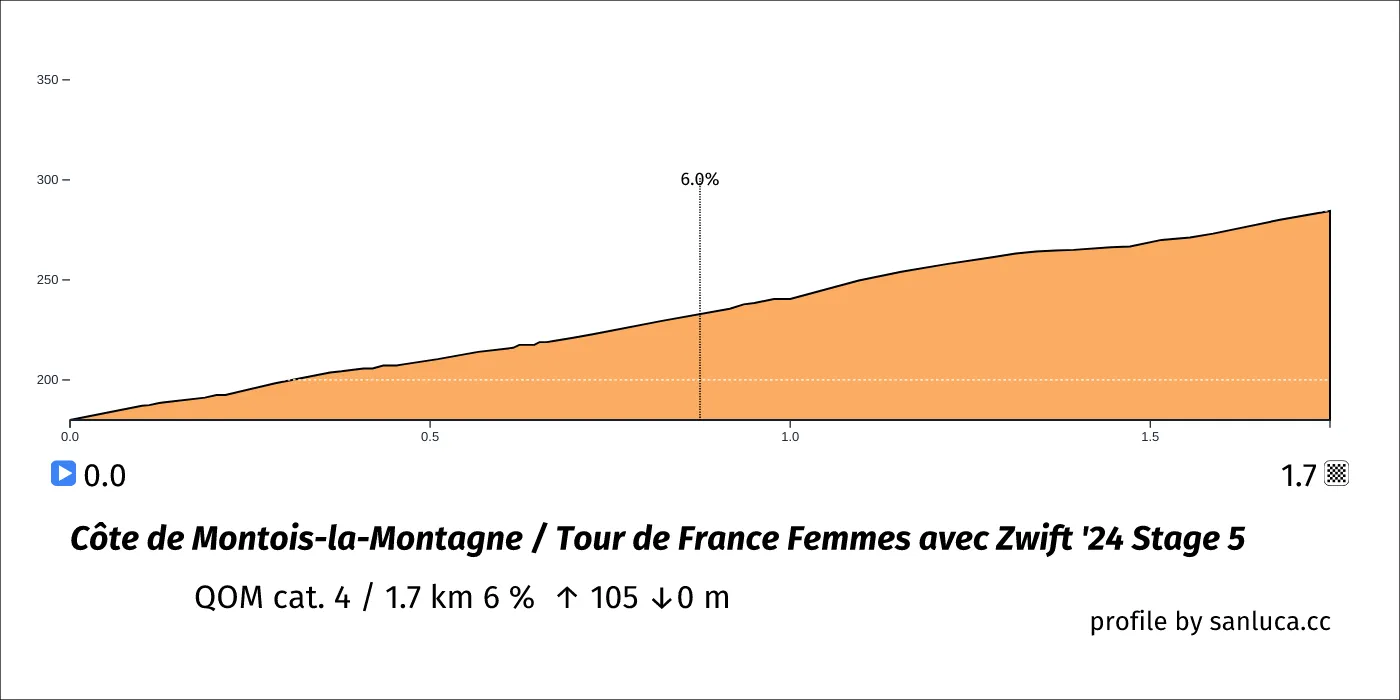
As the sprinters have already had two completely flat stages, ASO couldn't just make another sprint finish that favors them fully. For that reason, they have made the last ~1.4 km slightly uphill (3.4% avg).
With around 1.45 km to go, the riders will turn sharp right, the road will then rise with around 5% for 600 meters before getting to a roundabout where they take the second exit, after the roundabout, the road will rise with around 2% for the final 850 meters. This will test the endurance of the sprinters and make for a fun final.
Explore the final 3k of this stage with our interactive map.
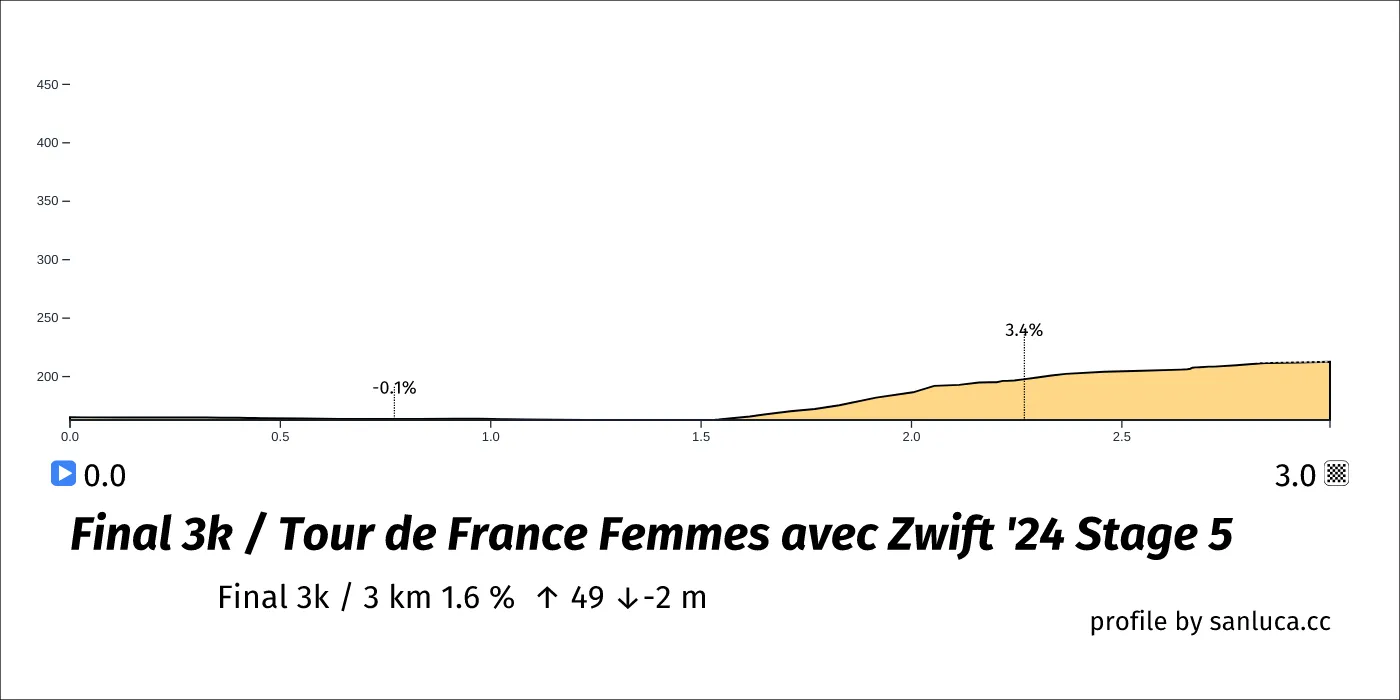
sanluca.cc tip: If you want to get a feel for the gradients in the final, you can see it in 3D by going to the interactive map, toggling off "Base map" and panning around in 3D (PC: use right mouse button, Mobile: use two fingers)
The jerseys
Maillot Jaune and Blanc
This depends on what happens on and after Côte de Montois-la-Montagne. Unfortunately, the most likely scenario will probably be that none of the GC riders will test each other in any serious way as there are only 6, 4 and 2 seconds up for grabs on the bonus sprint. If something happens, the riders of course need to be awake, but we are still not talking about more than a handful of seconds in the end. The same is also the case for the uphill sprint.
Importance: 3/10
Maillot Vert
The only stage to give 50 points to the winner which is not pancake-flat. With a lot of scenarios in the air, it is hard to say exactly how much influence this stage is going to have, but some of the riders with a bit more endurance who are also trying to win the jersey will definitely be ready today for a chance to grab a good load of points. No matter what, 50 points is a lot and will have an influence in the end.
Importance: 6.5/10
Maillot à Pois
With only 11 points as the max today, this stage will not be where the winner of the Maillot à Pois is decided. It could give a rider a bit more comfortable lead, but that's also about it.
Importance: 3/10
Stage 6
Explore this stage in detail with our interactive map.
The last stage of the race that doesn't finish on top of a mountain, but of course still with an uphill sprint. With a distance of 159.3 km, the peloton will travel from Remiremont to Morteau on yet another hilly stage. With the mountain weekend coming up, the contenders for the GC might take it easy on this stage.
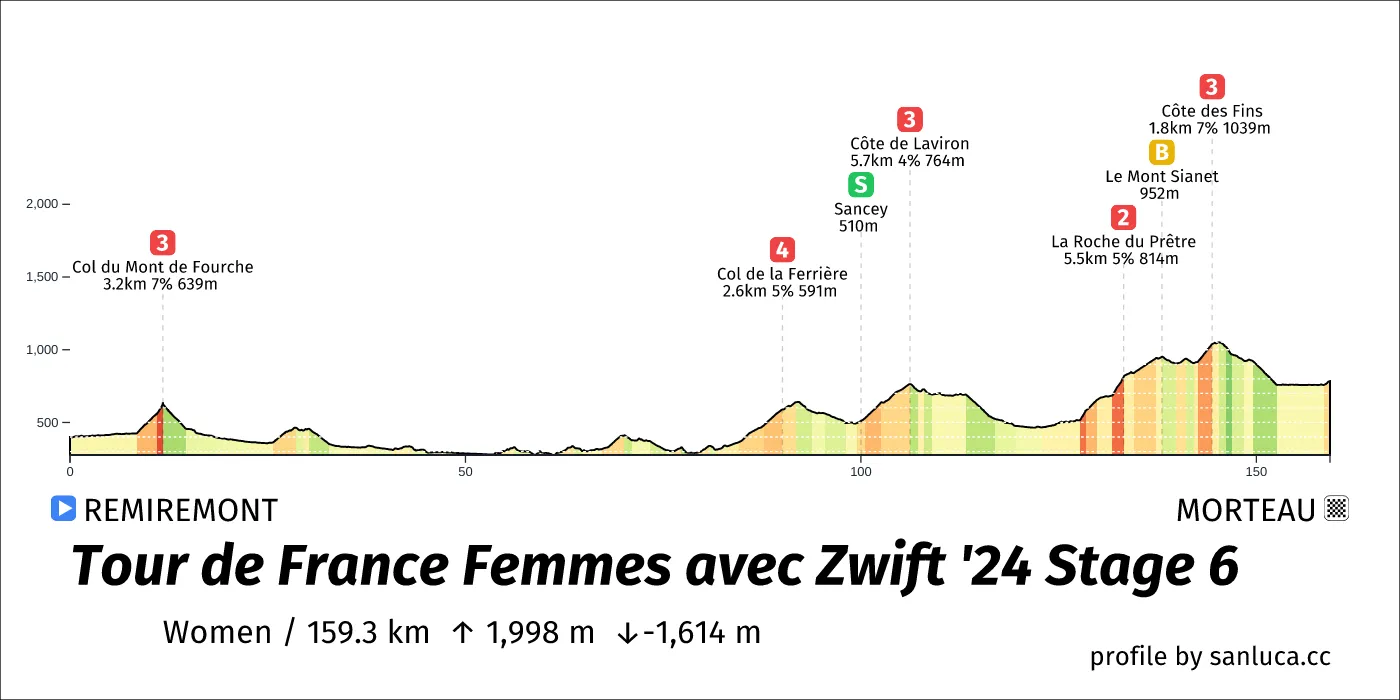
The stage kicks off with a cat. 3 climb after 8.5 kilometers which is a good place for a breakaway to get going. After that, it is mostly low-gradient climbs and an intermediate sprint until kilometer 127.7 (31.6 km to go) where La Roche du Prêtre, the only cat. 2 of the day, begins. It is a climb of 5.5 kilometers with an average gradient of just 5.4%, but with in total about 2 kilometers with 9%. At the top, it doesn't stop going up and keeps doing so for around 4.8 kilometers with 3.1% up to the bonus sprint.
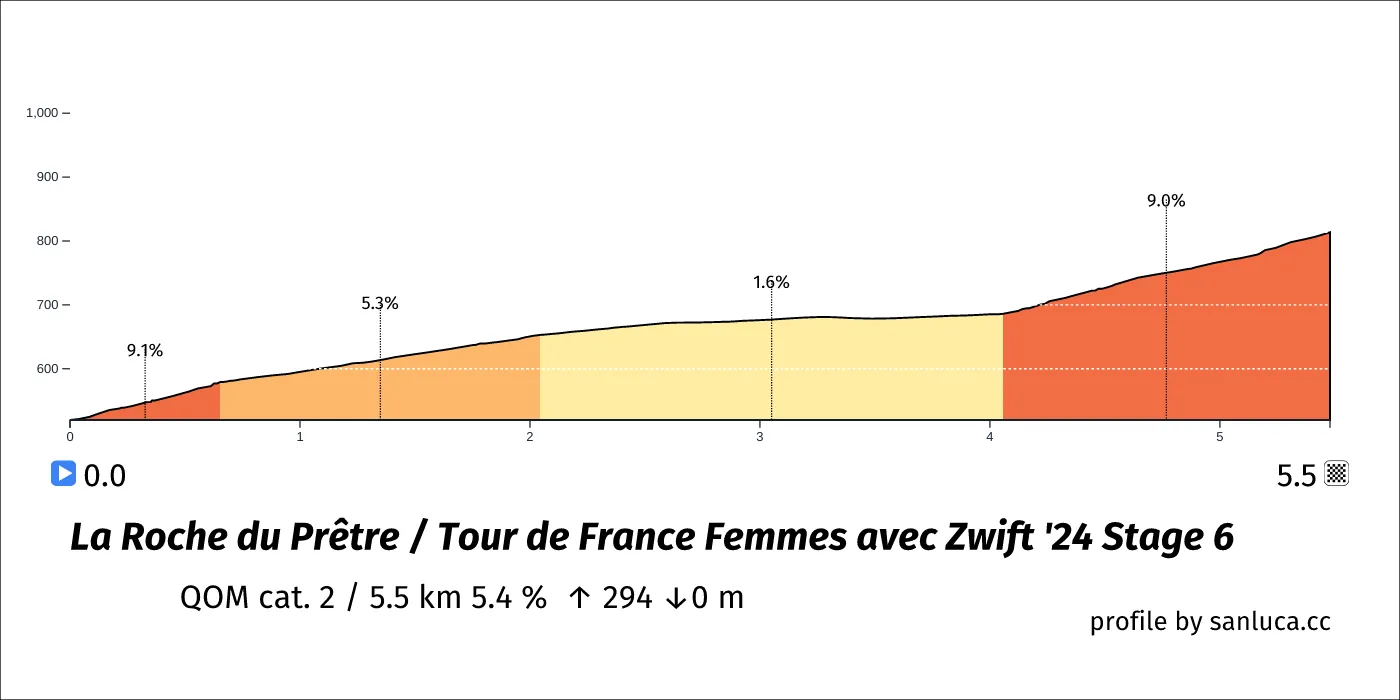
The last climb of the day ends with 15 kilometers to go and is 1.8 km with 6.8%, perhaps enough for an attack. After an 8k downhill section, it is virtually flat for 6 kilometers before coming to the uphill sprint.
With 870 meters to go, the peloton will turn right in a roundabout after which it will begin going slightly uphill. With 600 meters to go, it will start going more uphill for about 330 meters at 4.7%. The last 270 meters will rise with 2.6% with the last final meters to the finish almost flattening out. Yet again, this will be a test of the sprinters' endurance and should be fun to watch, there is also a roundabout with 500 meters to go.
Explore the final 3k of this stage with our interactive map.
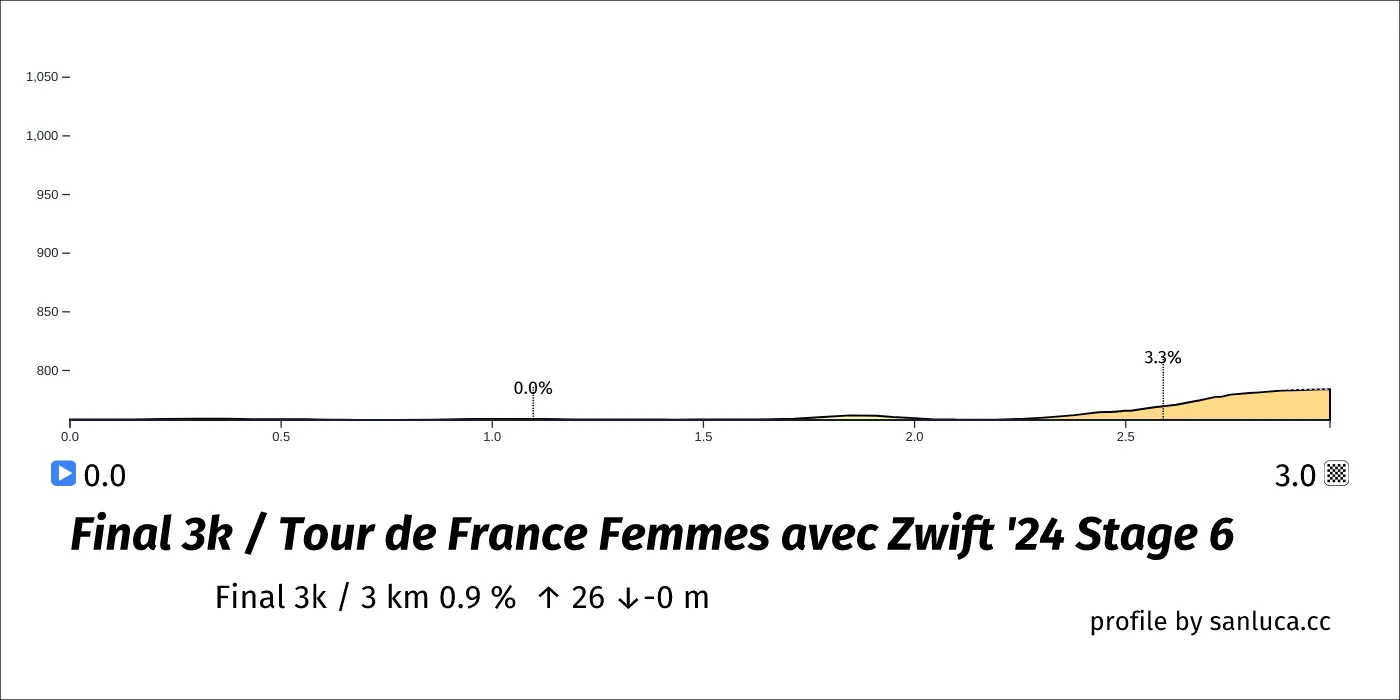
The jerseys
Maillot Jaune and Blanc
With the possibility of an attack, this stage could see some GC action. As mentioned, the favorites could also decide to wait until the weekend and take it easy today. With an uphill sprint you also never know what might happen.
Importance: 4.5/10
Maillot Vert
Depending on the standings, this stage could either be really important or not important at all. With 30 points on the line and another uphill finish, the riders with more endurance might be at it again to try and take some valuable points, and it could make the competition more interesting.
Importance: 5/10
Maillot à Pois
If someone takes maximum points today, they will be able to gain 16 points, approximately the same as the winner on Alpe d'Huez or Col du Glandon, it is kinda the same scenario as stage 5 where it could give a rider a more comfortable lead or perhaps get someone else into the competition, but not more than that.
Importance: 4/10
Stage 7
Explore this stage in detail with our interactive map.
Stage 7 is a medium mountain stage going from Champagnole to Le Grand-Bornand. It is the longest stage of this year's Tour de France Femmes with a total distance of 166.3 kilometers. It is also the only stage with a cat. 1 climb and the first stage with a mountain-top finish. Like we saw in the Giro d'Italia Women, it is possible to take the lead in the mountain classification on just one or two big mountains, and it might also be the case with the way this stage is designed.
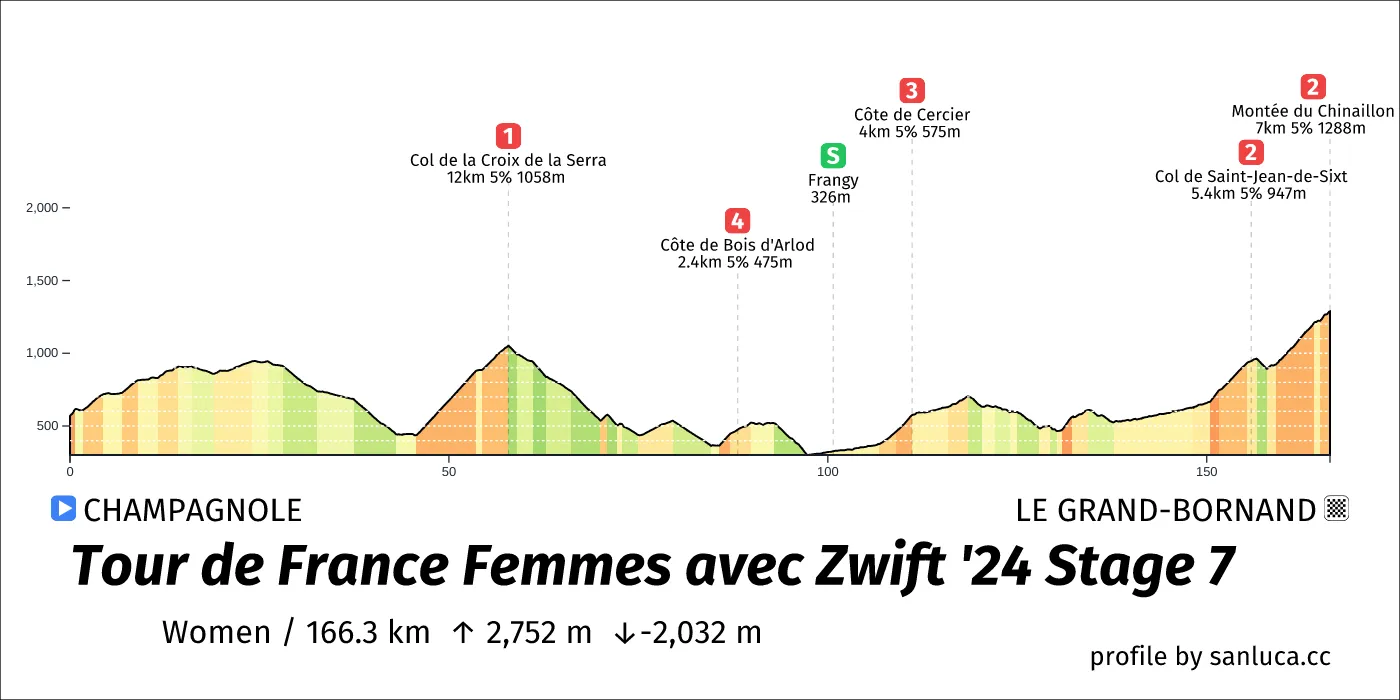
The stage starts with a hilly first couple of kilometers where we will probably see an interesting break formation phase, after this, there is a downhill part until the start of the cat. 1 Col de la Croix de la Serra. The early placement of this climb suggests that a break should take the points and thereby make the fight for the Maillot à Pois more interesting. After the climb, there are some minor categorized climbs until we begin the ascent to the finish line via no more than two cat. 2 climbs separated by a small 1.3 km downhill part.

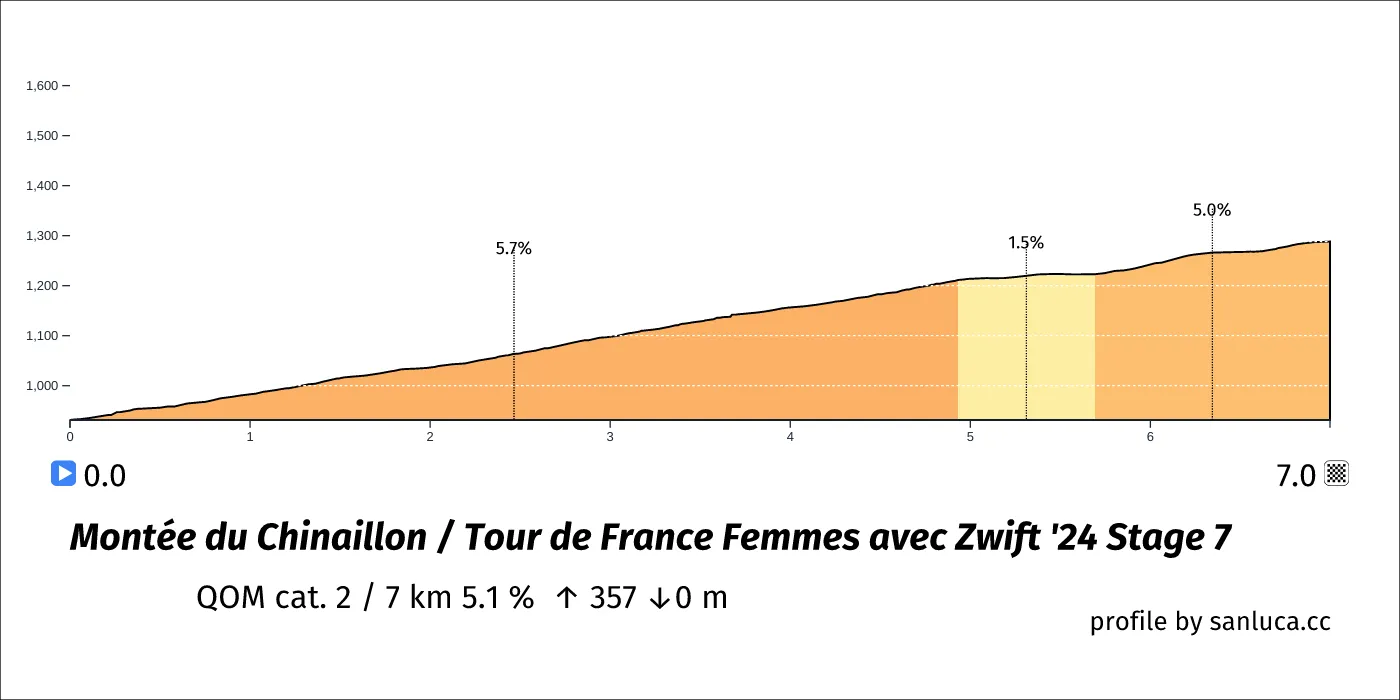
The climbs do not have super hard gradients, and should be fairly easy for the most part, but with around 12.5 kilometers of climbing in total. With the stage being relatively easy from the bottom of the Col de la Croix de la Serra, we could very well see the stage be ridden hard towards the final, and a GC battle that may or may not end up having some noticeably big gaps.
The final reminds me a bit of the second stage of this year's Giro d'Italia Women where we saw a late attack and small gaps in the GC group (Results here).
The jerseys
Maillot Jaune and Blanc
With a mountain-top finish, we should see some attacks and gaps on the line. A total of 12.5 kilometers of climbing at 5% is still something and will hopefully be spectacular to watch. The gaps will probably not be as big as on the Alpe d'Huez, but will set a precedent and an internal ranking in the peloton between the different GC riders and teams.
Importance: 8/10
Maillot Vert
With only 20 points possible for the sprinters in the intermediate sprint, this is not really a day that can decide the Maillot Vert unless the competition is really close. Even then, the riders would still have to endure two categorized climbs in the breakaway.
Importance: 3/10
Maillot à Pois
The cat. 1 climb being placed early on the stage is an invitation to all the breakaway riders who want a shot at the Maillot à Pois and will be crucial for the final standings. The final mountain and 2 cat. 2 climbs give out the same amount of points and could therefore make the battle even more spectacular with both break and GC riders hopefully going for it. 25 points maximum on this stage, but condensed into fewer climbs.
Importance: 7/10
Stage 8
Explore this stage in detail with our interactive map.
21 hairpins, 13.8 kilometers and an average gradient of 8%. It is time for the last stage of the Tour de France Femmes going from Le Grand-Bornand up to the mythical Alpe d'Huez. 150.2 kilometers and 3 categorized climbs (of which 2 are HC). This stage is set out to be a worthy final to an exciting Tour de France Femmes.
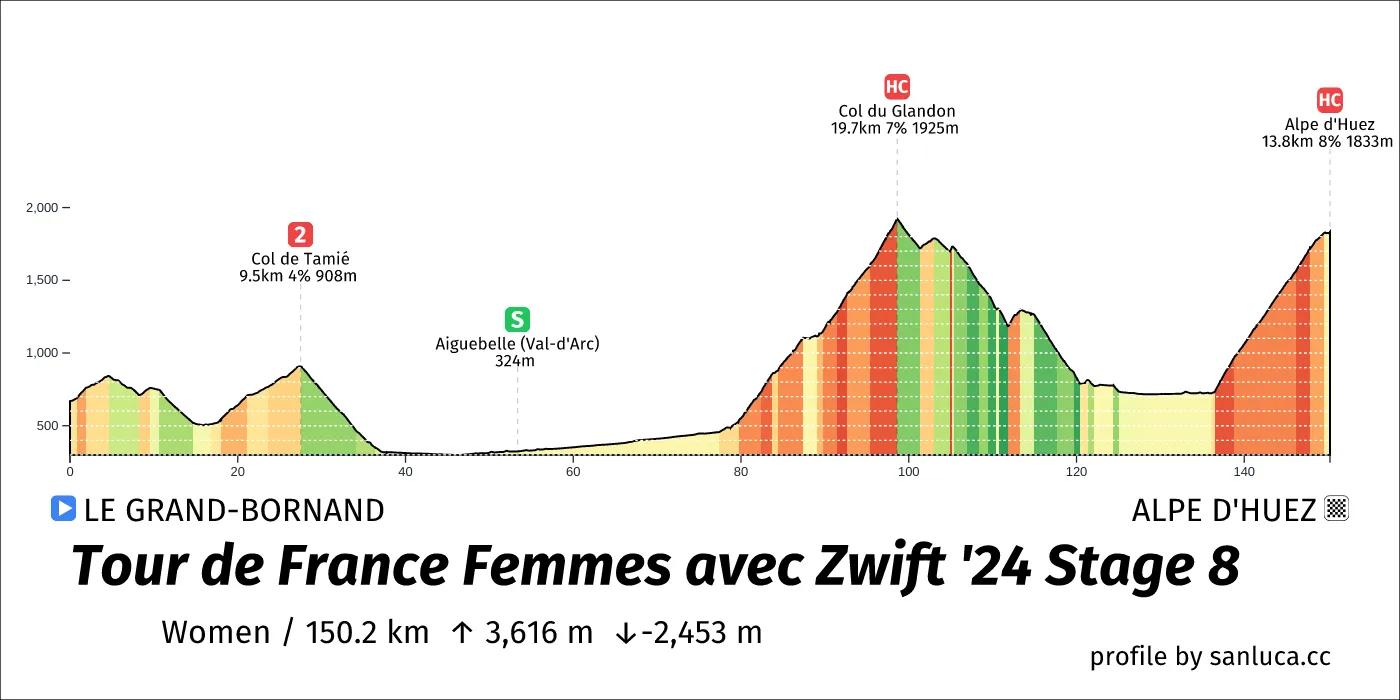
Already at the start, this stage is going to be tough with an uphill start and then the Col de Tamié after just 18 kilometers. After that, there is a last opportunity for the sprinters to get some points for the Maillot Vert at km 53.4 (96.9 km to go) with the final intermediate sprint and 20 points for the first rider. After that, the peloton will start preparing for Col du Glandon followed by Alpe d'Huez.
Col du Glandon is a 19.7 km beast with an average gradient of 7.3% but with the last 3.5 km rising with no less than 10%. As it is a HC climb, the first rider at the top gets 15 points for the Maillot à Pois (more than what was given out on stages 1, 2, 3 and 5 in total). It could very well be that a break goes early and gets the points on this climb which might be enough to decide the Maillot à Pois.
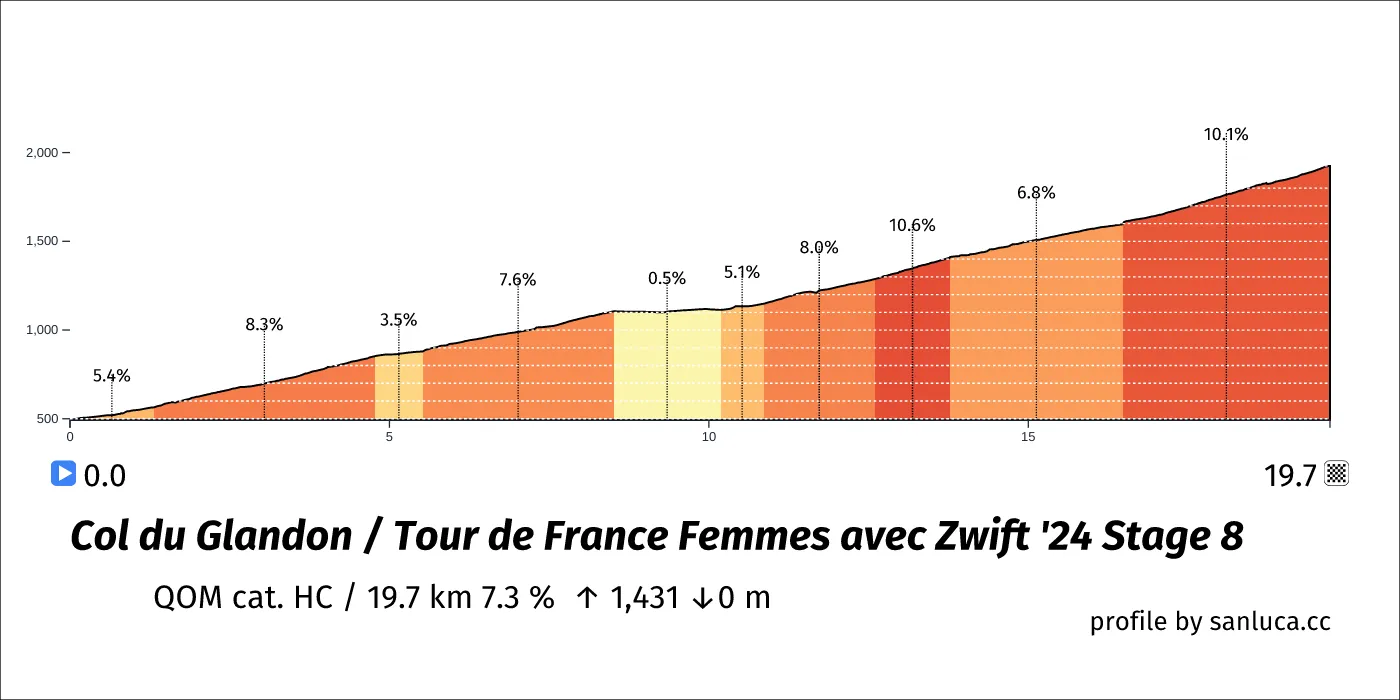
After the Col du Glandon, the riders will go downhill and then ride just under 20 kilometers flat before getting to the bottom of the Alpe d'Huez where the winner of the Tour de France Femmes will most likely be decided. With 13.8 kilometers at 8%, this climb is sure to create a lot bigger gaps than the finish yesterday, and probably enough so that the winner on Alpe d'Huez will also be the winner of the Tour de France Femmes.
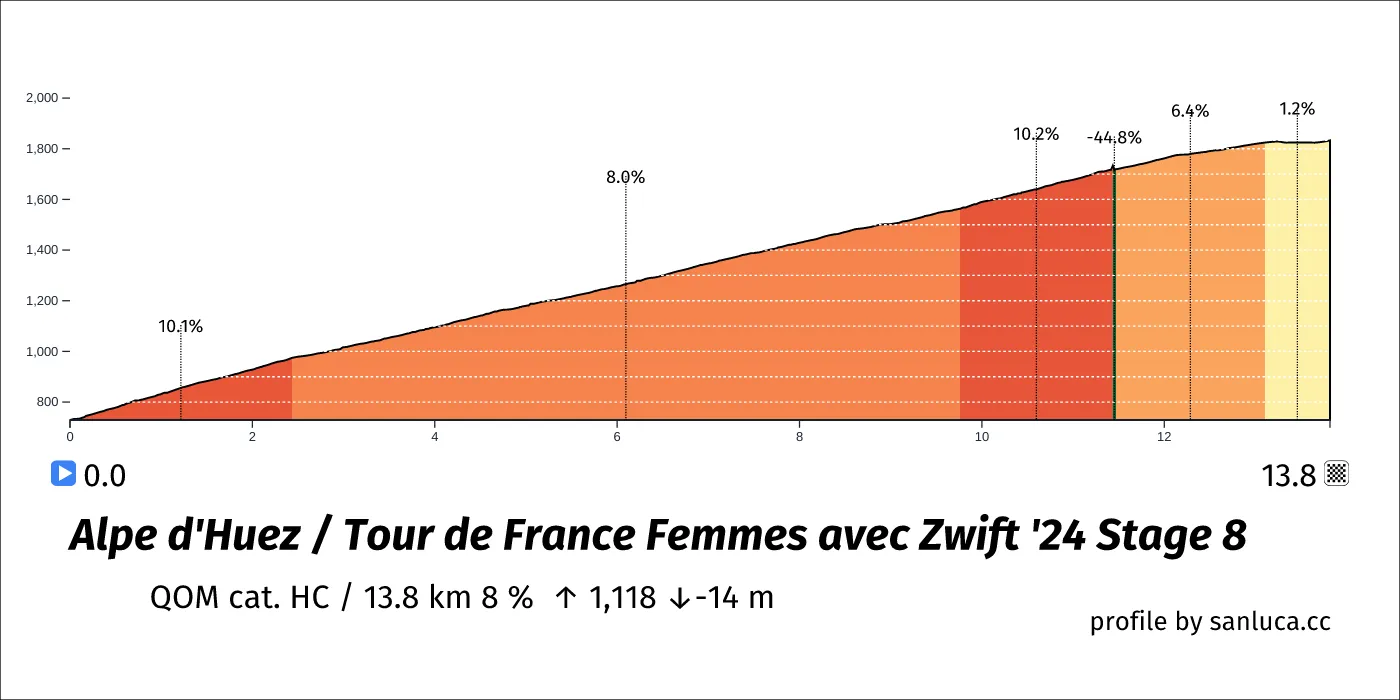
The jerseys
Maillot Jaune and Blanc
This is the stage, any rider that wants a shot at either the Maillot Jaune or the Maillot Blanc has to give everything today. It is sure to be an exciting stage with drama and fireworks almost from km 0 and hopefully the fans will be ready on the Alpe d'Huez for the epic GC battle.
Importance: 10/10
Maillot Vert
Just like with stage 7, this stage should not be able to decide the Maillot Vert unless the competition is really close. Again the riders would have to endure an uphill start and a cat. 2 before getting to the intermediate sprint.
Importance: 3/10
Maillot à Pois
A total of 35 points up for grabs today could mean that the Maillot à Pois gets decided today on either the Col du Glandon or Alpe d'Huez, and depending on the standings before the stage, it could be either a breakaway rider or GC rider that wins it.
Importance: 9/10
Conclusion
In conclusion, the route for this Tour de France Femmes looks really exciting. From a sprinter's start to the Alpe d'Huez on the last stage, this route has it all.
There are a lot of stages that can end up being interesting in the battle for the final GC and both the Maillot Jaune and Maillot Blanc. With a short ITT on stage 3 and the AGR/LBL stage on stage 4, we can hopefully be treated to some attacks and small gaps early on, but the real GC fights will happen on stage 7 and 8 which will decide the winner of the Tour de France Femmes.
The first two stages can give someone a huge lead in the fight for the Maillot Vert, but with the last couple of stages and especially stage 5 and 6, it could also end up being someone with a bit more endurance who ends up winning the jersey.
For the Maillot à Pois, there are many possible scenarios. It can very well end up being a GC rider winning the jersey with the points available on both stage 4 and the mountain-top finishes on stage 7 and 8. It can also be a non-GC rider with all the points available outside the mountain-top finishes, especially with Col de la Croix de la Serra on stage 7 and Col du Glandon on stage 8.
So sit back, enjoy the race and let's all hope for a great battle for all the jerseys.
If you found this preview useful, please do not hesitate to share it on X (Twitter) or other social medias. If you have any feedback, feel free to contact us either via email or on X (Twitter).